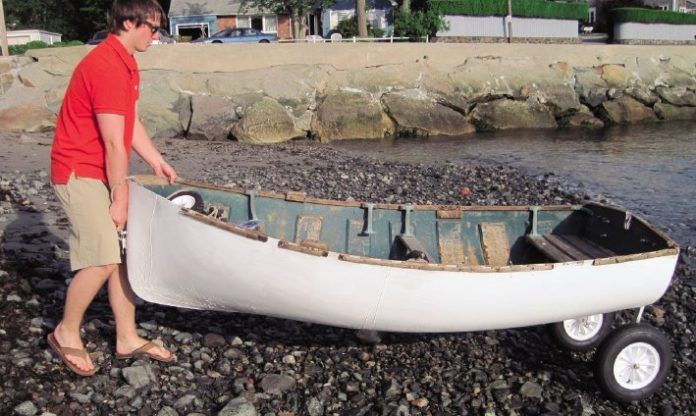As I creaked into action this spring, juggling refit projects like chainsaws, each one intent on drawing blood, I found I’m suddenly not as spry as I used to be. I blamed it on idleness, not age, for acknowledging time’s passage is the first step toward feeling its pinch. I am wiser this year, not weaker—right?
So, as refit projects kept me busy, I found myself rifling through back issues looking for buried do-it-yourself gems that would sustain the illusion of perpetual youth. This week’s blast from the past is a real back saver.
This project will help you turn some scrap plywood, a few screws, and a lawnmower axle and wheel set into durable and inexpensive portable dinghy wheels. If rocky terrain is in your future, you might want to commit to our top pick for bolt-on dinghy wheels from Danard Marine. You can also check out our full report of our test of dinghy wheels, which includes options that are a less expensive than Danard Marine’s—but not as cheap as this one.
The beauty of the design is that it is portable, something that will fit in a lazarette almost as easily as it fits in a car trunk (that’s the boot, for our UK readers). Sure, it occupies a little more room in the dinghy while going ashore, but if the dinghy is too heavy for two people to carry ashore, it probably has room for these.
If you are shopping for a dinghy, Practical Sailor’s archives has dozens of reports on dinghies, covering everything from roll-up inflatables to ultralight carbon-fiber hard dinghies.
And if you are natural-born do-it-yourselfer, or aspire to being more self-sufficient, we’ve built up an impressive library of do-it-yourself projects like this. One of the more interesting trends I’ve observed over the years is how advances in materials science (LED illumination, high-molecular weight fibers, high-strength glues) have made it possible for someone with average mechanical skills to build first-rate gear for their boat and save a bundle.
If you’ve got a DIY project you’d like to share with the sailing community, drop me a line at practicalsailor@belvoir.com. And if you’ve reinvented you’re own DIY dinghy wheel, we’d love to hear about it, either with a comment below or via email (same address as above) for our Mailport section in the print issue.
Do-it-Yourself Dinghy Wheels
 Materials
Materials
For the do-it-yourself dinghy wheels, here’s what you’ll need:
- One pair of lawn mower wheels, 8-inch diameter with axle, washers, and wheel caps. ($10 or less)
- One pair of metal brackets to fasten axle to bottom of wood panel. ($3)
- 24 inches of rope, roughly a half-inch diameter; most any kind will do. ($1)
- Wood glue. ($2)
- One-quarter sheet of -inch plywood. Marine grade is best but not a must. (lumber yard surplus, $5)
- A dozen self-tapping stainless screws, 2-inch length. ($2)

Step-by-step
1. Cut two panels of plywood, one 14-by-11.5 inches, the other 14-by-9 inches. Also cut three spacers, 14-by-9 inches each.
2. Glue and screw one of the spacers to the larger of the two wood panels, making an L-shape. The screws should be started into the wood panel and enter the spacer.
3. Glue and screw the second smaller wood panel, only this time, start the screws into the spacer, and then enter the wood panel. You should end up with what looks like a U-shape, with one wood panel slightly shorter than the other.
4. Screw the two axle brackets into place on the bottom spacer and fit the axle and wheels. Take one of the two remaining spacers, and glue and screw it directly onto the spacer already in place.
5. Then slip the entire device onto the transom of your dinghy to take a quick measurement. The wheels must not rub against the gunwale on the transom. To ensure clearance, screw the third spacer into place inside the U at a point that stops the transom from going any deeper.
6. Drill two holes into the larger (outside) wood panel for the rope. Tie knots in both ends of the rope. This will provide a carrying handle and an easy way to slip the device onto the transom, if the dinghy is stored in a rack or the back of your SUV. As you pull the dinghy from the rack, hold the device in place using the rope handle and slowly set down the dinghy.





































Hi, Nice idea but I am having difficulty with the dimensions of the spacers @ 14″x 9″ same size as the inner piece? A close-up picture might help.
Thanks
I too can’t visualize this from the instructions and the photos.
The second and third spacer must have to be cut shorter to fit in between, the width of plywood x1 subtracted